Imagine submerging yourself into a world where sharks swim along the currents, schools of barracuda swirl like a silver tornado, and vibrant corals cling to steep underwater walls. This is Blue Corner, Palau’s most legendary dive site and one of the best dive spots on the planet.
If you’re planning a dive trip to Palau, the Blue Corner should definitely be on your list! In this guide, we’ll explore everything you need to know to make the most of your dive at this breathtaking destination.
What Makes Blue Corner in Palau a Popular Diving Destination?
There are several things that make Blue Corner so famous among the diving community. First, the site has a unique topography that features a coral-covered wall that plunges into the deep alongside a flat plateau, attracting a wide range of marine life.
You can find reef-dwelling species around the steep wall, like anthias, butterflyfish, and moray eels. In contrast, the flat plateau attracts larger pelagic species, like schools of barracuda, reef sharks, and Napoleon wrasses. The strong currents, though challenging, bring the underwater world to life, offering plenty of exciting opportunities for drift diving.
Beyond its vibrant ecosystem, Blue Corner also has excellent visibility, ranging from 16m to over 28m, allowing you to immerse yourself in the ocean’s stunning landscapes. Palau’s pristine underwater landscapes are a direct result of its strong commitment to marine conservation, ensuring that the region’s rich ecosystem remains vibrant and thriving for generations to come.
Which Marine Species Can I Encounter at Blue Corner, Palau?
1. Gray Reef Sharks
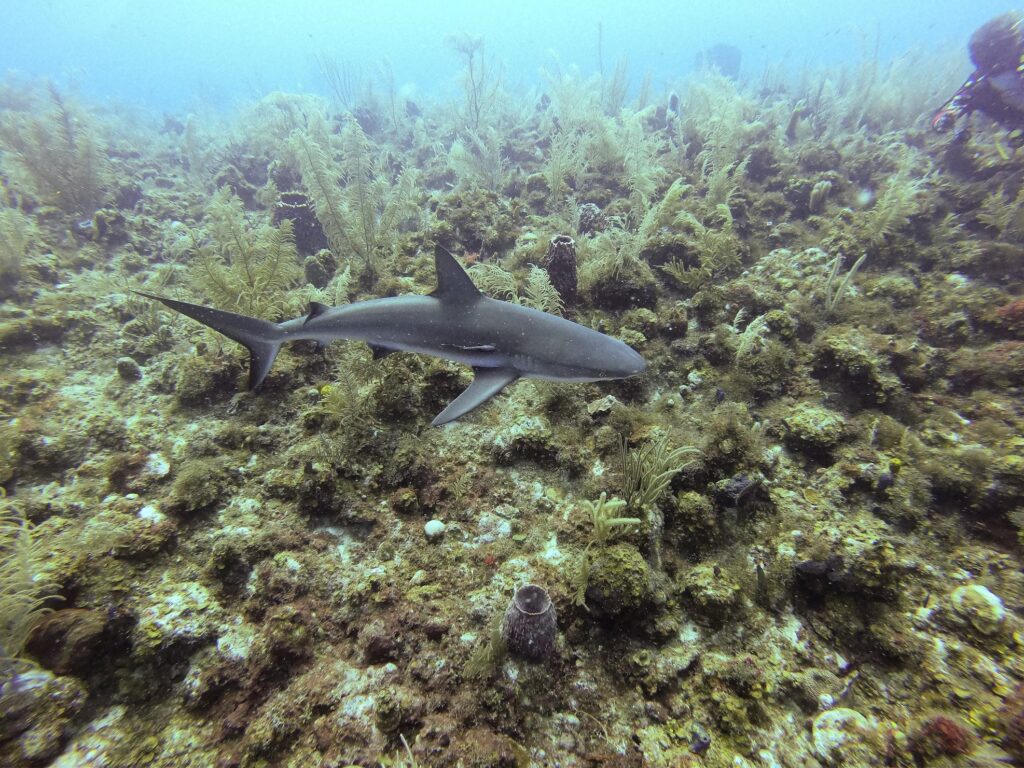
Known for their dark-gray colors and white-edged fins, the gray reef sharks are one of the many creatures you can find in Blue Corner. They are often seen swimming along the strong currents around the steep coral wall or circling the plateau, particularly during incoming tides. The best way to spot them is by going on a drift dive, so remember to bring a reef hook to steady yourselves amid the flow.
2. Napoleon Wrasse

Also called the humphead wrasse, this striking fish is known for its beautiful blue-green scales and a prominent hump on their heads. Don’t be intimidated by their size, as Napoleon wrasses are gentle and intelligent. You can find them leisurely cruising along the reef edges, feeding on crustaceans, mollusks, and crown-of-thorns starfish, which helps keep the reef ecosystem in balance.
3. Barracudas

The schools of barracuda are one of Blue Corner’s most stunning spectacles, often forming massive, tornado-like formations in the strong currents. Drawn by nutrient-rich waters, these sleek predators gather by the hundreds—or even thousands—hovering near the plateau’s edge to hunt smaller fish. Many divers are looking forward to witnessing this beautiful phenomenon, which adds an exhilarating thrill to their diving journey.
4. Manta Rays

Though manta rays are more commonly seen in the neighboring site, German Channel, you can occasionally spot these gentle giants in Blue Corner, particularly during plankton bloom seasons. Their massive size, combined with their curious and friendly nature, creates an awe-inspiring spectacle that never fails to stun any divers.
5. Eagle Rays
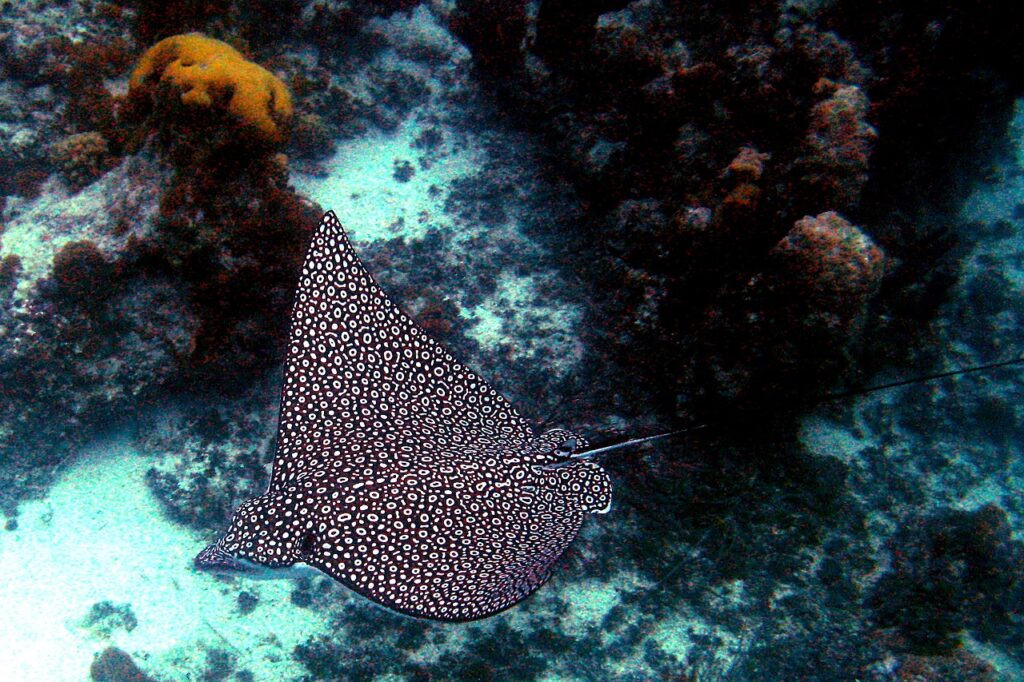
Aside from manta rays, you can also spot eagle rays in Palau’s Blue Corner, whether in small groups or alone. Unlike mantas, eagle rays are more shy and tend to keep their distance from humans. However, divers still adore them for the beautiful spotted patterns on their bodies and their graceful movements. Their visits to Blue Corner are unpredictable, but when they do appear, their elegance and rarity make them a cherished highlight.
6. Green and Hawksbill Turtles

The healthy coral reefs and nutrient-rich waters in Blue Corner also make it an ideal place for green and hawksbill turtle sightings. The green turtles are often spotted around the plateau or feeding on seagrass beds, while the hawksbill turtles are more commonly seen near the coral-rich walls where they feed on sponges.
7. Moray Eels
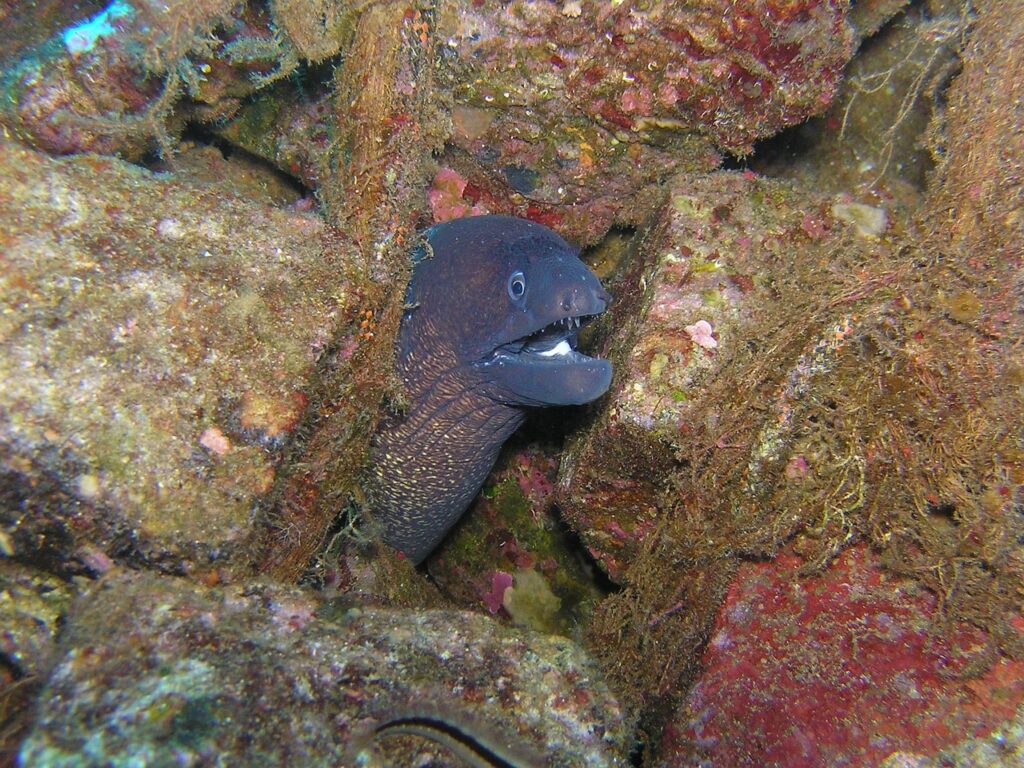
The coral crevices and rocky overhangs in Palau’s Blue Corner provide the perfect habitat for the moray eels, particularly the giant moray and peppered moray. You may often spot them peeking out from the shadows, waiting for prey. Despite their fierce look, moray eels are generally shy and prefer to stay hidden, only emerging at night to hunt. During the day, you may see them being cleaned by small shrimp or wrasse, creating a unique underwater interaction.
When is the Best Time to Go Scuba Diving in Blue Corner, Palau?
Generally, Palau has great conditions year-round for diving. However, if you’re looking for the best weather, you’re highly recommended to dive during the dry season, which is between November and April, when the seas are calm, with minimal rainfall and peak visibility.
Are There Any Other Dive Sites in Palau?
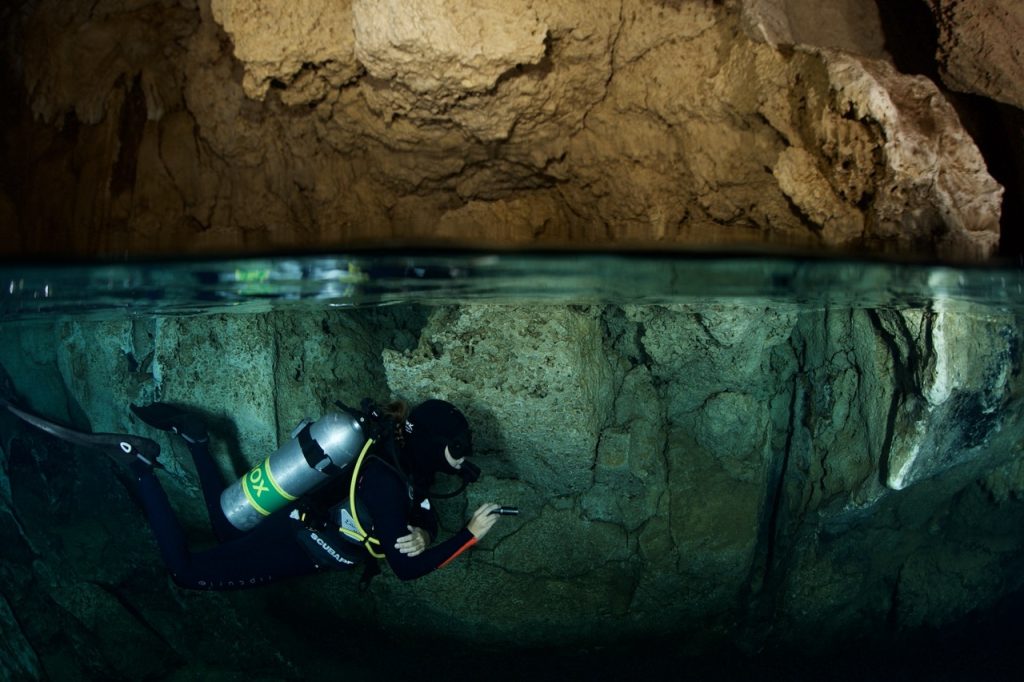
As a tropical paradise, the Blue Corner isn’t the only magnificent dive site you can find in Palau. In fact, there are several other iconic, world-class diving spots that you can and should check out during your visit. Here’s a short list of the best dive sites in the region:
- Blue Holes: A series of underwater caverns that open up to an exit near Blue Corner. Due to their close proximity, diving at both sites on one trip is a must for an unforgettable experience.
- German Channel: One of the world’s top dive sites for encountering manta rays, this site offers an unforgettable experience as these graceful giants glide effortlessly to their cleaning stations, often circling in mesmerizing formations.
- Ulong Channel: Renowned for its exhilarating drift dives, this site boasts stunning coral gardens and an abundance of reef sharks, making it a favorite among adventurous divers.
- Shark City: A hotspot for shark encounters, you can find gray reef sharks and even occasional hammerhead sharks here.
- Chandelier Cave: A unique underwater cave with several air pockets and beautiful stalactite formations. A must-visit for cave divers!
- Peleliu Express: A site known for its strong currents and large pelagic fish, making it an ideal spot for experienced divers to explore.
How Can You Plan Your Blue Corner Palau Diving Adventure?
1. Choose the Best Time
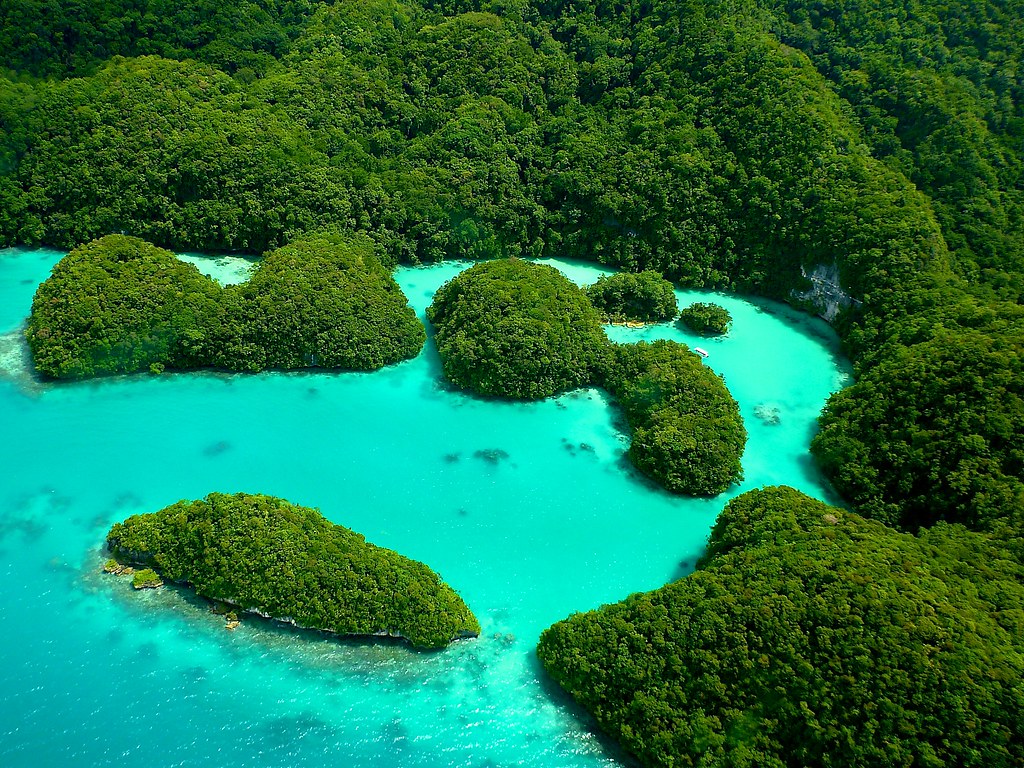
Before going, be sure to do proper research regarding the best time to visit Palau, particularly for diving or other underwater excursion. While the weather in Palau is pleasant year-round, the dry season is generally recommended for outdoor activities.
2. Book a Liveaboard or Dive Resort
To maximize your dive experience in Palau and specifically, Blue Corner, you’re highly recommended to book a liveaboard or a dive resort. With a liveaboard, you can easily access various diving sites, particularly remote ones, and enjoy multiple dives a day. If you prefer a land-based option, dive resorts provide comfort and easy access to local dive operators who run daily boat trips to Blue Corner and other iconic sites.
3. Check Certification and Experience Requirements
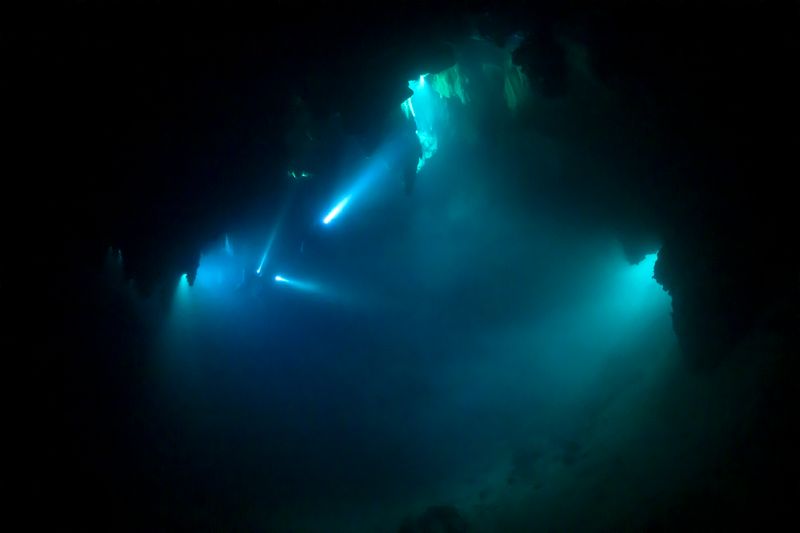
Blue Corner is best suited for advanced divers due to its strong, unpredictable currents. You’re going to need good buoyancy control and experience with drift diving to navigate the currents safely. In addition, you should also have a minimum of PADI Open Water Diver certification.
4. Essential Gears to Bring
There are several essential pieces of gear to bring for your dive trip to Palau and Blue Corner. A mask, fins, and a well-fitting BCD are must-haves for comfort and control in the currents. For exposure protection, Palau’s waters remain warm year-round, so a 3mm wetsuit is usually sufficient for most divers. While not essential, an underwater camera with a wide-angle lens is highly recommended to capture the incredible marine life and breathtaking underwater landscapes you’ll encounter.
What Are the Best Practices for Diving at Blue Corner, Palau?
Diving at Blue Corner can be challenging because of its strong and unpredictable currents. Having good buoyancy control and experience with drift diving will be important to stay safe. Divers are highly recommended to enter the water quickly and descend right away to avoid getting carried away by the current. It’s also important to stay close to diving guides and follow their instructions.
In terms of gears, a reef hook is very useful at Blue Corner, as it helps you stay in one place without damaging the coral. You simply hook onto a rocky area, let the current hold you in place, and enjoy the underwater scenery around you. Before your dive, practice using a reef hook so you can use it safely and correctly.
Let’s Explore Palau’s Blue Corner with Solitude World!

Experience the magic of the Blue Corner and Palau with Solitude World’s Liveaboard and Resorts!
Our liveaboard vessel, Solitude Gaia, can take you on an exciting journey across the best dive sites in Palau, from the Blue Corner to German Channel and Chandelier Cave! Guided by our PADI-certified dive experts, you’ll explore Palau’s breathtaking marine life with safety, comfort, and excitement at every turn.
Beyond the thrilling underwater excursions, Solitude Gaia also offers unparalleled comfort at sea. We offer well-appointed and comfortable cabins where you can relax, common areas for you to unwind, and delectable, chef-prepared meals that can replenish your energy after an exhilarating day under the water!
What are you waiting for? Book your next diving adventure with us here today!